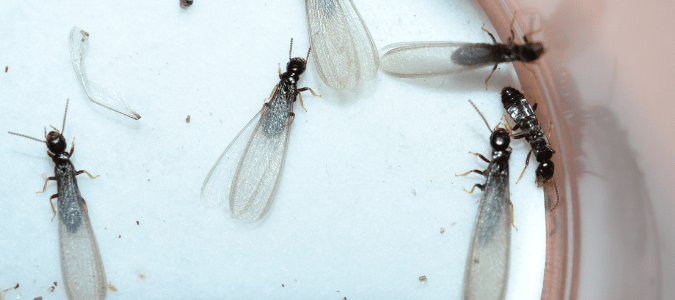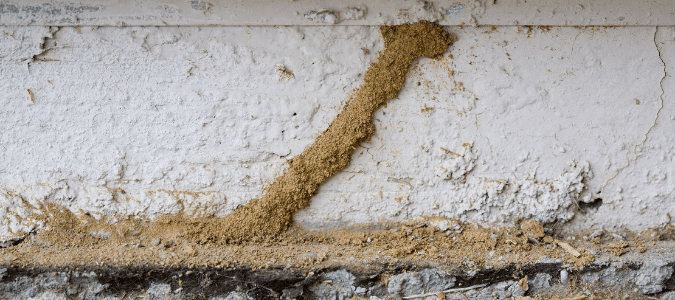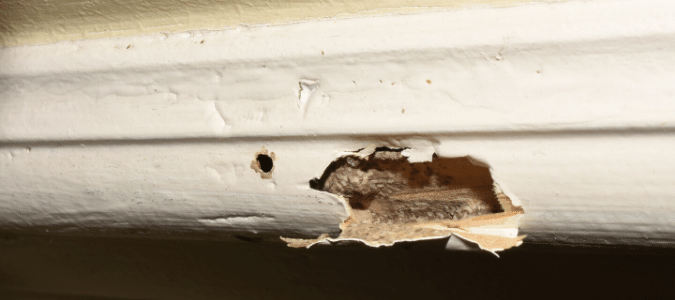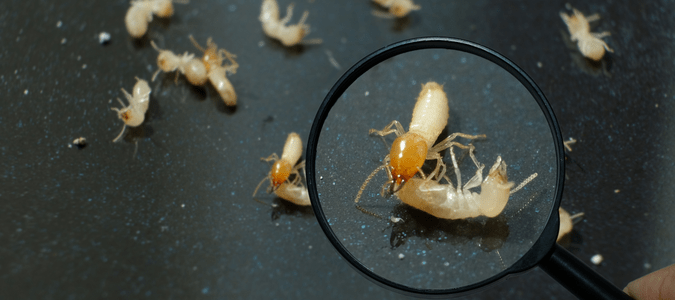Spotting dead termites on your windowsill is an unpleasant experience as a homeowner, and it means you have a bigger termite problem. Why do dead termites end up on your window sill, and what does it mean for the rest of your home?
Dead termites on your windowsill are a sign that swarmer termites were trying to mate and start new colonies on your property. It also means that there may be a pre-existing colony in your home.
Along with seeing termite swarms, there are other common signs of termites in your home. It’s important for homeowners to understand the signs so that they can act quickly to control a termite infestation.
Termites can cause costly damage to your home, and one of the worst species is the Formosan termite. This article will break down how to identify these pests, how to prevent them from getting inside your home and what to do if you spot them.
Why Are There Dead Termites On My Windowsill?
Termites usually live and work out of sight, so seeing dead termites on your windowsill is alarming and off-putting. However, it is a good way to learn that your home has a termite problem so that you can do something about it.
Dead termites on your windowsill indicate a termite swarm. Termite colonies have different types of termites, including “swarmers” which are reproductive termites with wings. During the warm spring and summer seasons, swarmer termites from subterranean species leave their colonies to mate and find places to start new colonies. They usually swarm after rainfall.
Drywood termites leave their colonies in the late summer months through November, so it’s possible to see dead termites on your windowsill throughout most of the year.
Swarmer termites leave during the daylight hours, and they are attracted to light, which is why they often end up on windowsills. You may also see them inside your light fixtures. When the swarmer termites can’t escape your home, they die. The dead bodies on your windowsills are termites that were trying to leave through the window but didn’t make it out.
If you see dead termites on your windowsill, it is a sign that a much larger termite colony is nearby in your home. Call a pest control specialist as soon as possible to deal with the infestation before they do more structural damage to your house.
Signs of a Termite Infestation
Along with seeing the bodies of dead swarmer termites, there are several other signs of a termite infestation. One common sign is the sound of hollow wood in your home.
Termites eat wood from the inside out, which means that they can do a ton of damage before you notice. Knocking on your wood beams, walls and furniture and listening for a hollow sound is one way to test if you have a termite problem.
Another common sign of termites is having warped doors and windows. Don’t ignore this and assume it’s because of warm weather. As termites eat through doors and windows, they produce moisture that warps the wood. If you notice that your doors and windows are stiff and hard to open, it could be because termites are eating away at them.
You may also hear termites at work in your home. Sometimes you can hear a munching sound as worker termites eat and travel through your walls. You might hear a quiet clicking sound, which is when soldier termites bang their heads against the wood. They do this to warn the worker termites that danger is nearby.
Unlike other types of termites, swarmer termites have wings and can fly. However, once they find a mate and settle into a new colony, they shed their wings. Spotting their discarded wings around your home is a sure sign that termites have infested your property. You may see them on your windowsills with the dead bodies, or you could discover them on the floor.
Termites infest wood through tunnels and mud tubes, pictured above. These structures act as a shelter. They aren’t easy to see, but you can find them if you look for them. It’s likely that you would find them around your property instead of inside your home. Look for exposed tunnels in broken pieces of wood.
Mud tubes are the width and color of pencils. They start on the ground and move into the wood. You can tell when a mud tube is new because it’s still wet, whereas an older mud tube looks dry.
If you notice any of these signs of termites in your home or around your property, don’t wait to contact a pest control specialist. Termites can cause expensive structural damage, so it’s important to address the problem right away.
Where Are Termites Found?
There are several places where you can find termites around your home and property. Where you find termites can tell you about which species of termites you have in your home.
For example, as their name suggests, drywood termites live in dry wood. Homes are full of places where Drywood termites can hide, such as on furniture, inside your home’s wood beams and on dry firewood. They often live in trees that are near your home and find small crevices to enter your house. Once they are in, they set up camp and start eating away at your dry wood.
Dampwood termites prefer living in extremely damp places like moist, rotting wood and soil. You likely would only find these termites on your property if you have water pooling in your yard near a shed or another wooden structure.
Subterranean termites like moist habitats. Outside, they will nest in soil, tree stumps and stacks of wet firewood. When they find their way inside, they will use their mud tubes and tunnels to keep their surroundings wet. This is also why it can be easy to mistake termite damage for water damage.
Termites have several entry points into your home. Cracks in your foundation, crevices in your wood door frames and fractures in your home’s mortar are a few examples.
One way to prevent termites is to remove wood-to-soil contact with your home. Your wooden siding should stay at least six inches off the ground. Additionally, keep cardboard and other debris away from your home, and do not stack firewood against your house.
If you have a wood fence, check it for rotting wood and replace it right away. Keep mulch away from your home since it provides a moist place for termites to live. You should also eliminate all moisture and dampness around your home’s foundation. Check your roof for water leaks, make sure storm gutters drain away from your home and do not point sprinklers toward your home’s foundation.
For more prevention techniques, contact a pest control professional. They can help you put prevention measures in place before termites cause costly structural damage.
Formosan Termite Identification: How Are They Different?
There are over 2,000 species of termites, but one of the most aggressive types is Formosan termites. They are a type of subterranean termites that are often referred to as “super termites.” They have giant appetites and can cause significant damage while going undetected for a long time.
Formosan termites look similar to other types of subterranean termites, but there are a few differences that set them apart. They have pale yellow or orange bodies, and swarmers have translucent wings. The color of their bodies is one way to tell Formosan termites apart from other types of termites, which are usually creamy brown.
These pests also have longer bodies than other types of termites and measure about half an inch. In comparison, other subterranean termites measure between an eighth of an inch to three eights of an inch in length. However, they have shorter heads with short pincers attached.
Swarmer Formosan termites are often mistaken for flying ants; but, they have broader waists. Soldier Formosan termites have tapered heads, whereas other types of subterranean termites have square heads.
One reason why Formosan termites can cause more damage than other types of termites is that they tend to have larger colonies. The signs of Formosan termites, such as hollowed-out wood, discarded wings and damaged door frames and window sills are the same as other types of termites.
If you spot Formosan termites or a sign of their presence in your home, contact a professional pest control service right away. These pests are extra devious, so do not wait to eradicate the infestation.
ABC Can Help Get Rid of Termites
As a homeowner, one of the last things you want to deal with is a termite infestation. If you spot termites, contact our experts at ABC to get a termite control specialist to your home right away. When you contact ABC Home & Commercial Services, you can have peace of mind that your biggest investment is protected.




